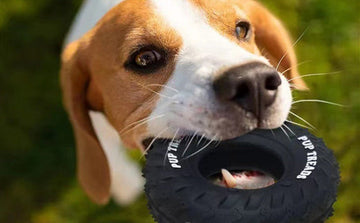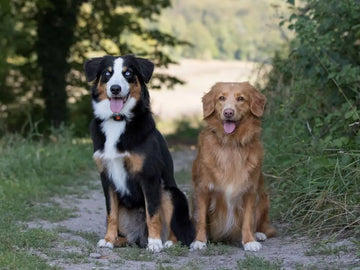Dogs are known for their playful nature, and toys are essential to their well-being. However, it can be frustrating when a dog destroys their toys quickly or develops destructive behavior. Whether it's chewing through plush toys, ripping apart rubber balls, or tearing up ropes, this behavior can be discouraging. Fortunately, with the right techniques, you can teach your dog to treat their toys with respect, which will help preserve the longevity of your dog’s toys and ensure they get the most out of their playtime.
1. Understanding Why Dogs Destroy Toys
Before jumping into the solutions, it’s important to understand why your dog might be destroying their toys in the first place. Dogs have natural instincts that drive them to chew, and it’s essential to recognize the root cause of the destruction before addressing the issue.
Natural Chewing Instinct
Chewing is a natural behavior for dogs. It helps them keep their teeth clean, and it serves as a form of entertainment and stress relief. Puppies, in particular, are prone to chewing due to the teething process, while adult dogs may chew to relieve anxiety or boredom. For some dogs, chewing is simply a fun and rewarding activity.
Boredom and Lack of Stimulation
Dogs who don’t have enough mental or physical stimulation are more likely to engage in destructive behaviors. If a dog doesn't have enough to do, they might turn to their toys as an outlet for energy. In this case, the destruction isn’t malicious but rather a result of the dog needing more engaging activities.
Separation Anxiety
Some dogs experience separation anxiety, leading them to destroy toys (and other items in the home) when left alone. The anxiety causes dogs to act out, often by chewing on things to relieve stress. This behavior can be exacerbated if your dog has a close attachment to their toys.
Improper or Low-Quality Toys
If you’ve been using toys that are easily destroyed or aren’t suited to your dog's chewing strength, it’s likely that they’ll tear them up. Soft, poorly made toys won’t hold up to a dog’s strong jaws, especially if they’re an avid chewer. Sometimes, dogs will destroy toys simply because they’re not built for durability.
2. Choosing the Right Toys for Your Dog
One of the most important steps in preventing destructive behavior is choosing the right toys for your dog. Not all toys are created equal, and selecting ones that suit your dog’s chewing habits, age, and energy level can make a big difference.
Durable, Chew-Resistant Toys
When shopping for dog toys, look for options that are designed for durability. Rubber toys and sturdy plastic options can withstand rough chewing and provide hours of fun. Consider investing in high-quality toys that are designed specifically for chewers. For example, dog rubber ring toys are a great option for dogs who love to chew, as they are both long-lasting and engaging.
Age-Appropriate Toys
Dogs of different ages have different needs. Puppies, for example, will often go through a teething phase, where they are prone to chewing on everything. Puppy-specific toys tend to be softer, making them ideal for this stage. For adult dogs, toys that are harder and more durable, like rubber rings and Kong toys, may be better. Always check the packaging of the toys to ensure they are suited to your dog’s age and chewing behavior.
Safe, Non-Toxic Materials
It's important to choose toys that are safe for your dog. Look for toys made from non-toxic materials that won’t harm your dog if they bite, chew, or swallow small pieces. Many toys are made with rubber, which is a great material for chew toys and safe for most dogs. Be sure to avoid any toys with small, detachable parts that could be a choking hazard.
3. Training Techniques to Prevent Destructive Behavior
Now that you understand why dogs destroy toys and how to choose the right ones, it's time to focus on training your dog not to destroy them. Effective training involves a combination of consistency, positive reinforcement, and redirection of behavior.
Positive Reinforcement: Rewarding Good Behavior
One of the most effective ways to teach your dog not to destroy their toys is to reward good behavior. Positive reinforcement is a proven training technique that encourages desirable actions by offering a reward. When your dog plays with their toys appropriately (without destroying them), immediately reward them with praise, a treat, or extra playtime.
Redirecting Attention to Appropriate Toys
If your dog starts chewing on something they shouldn’t, it’s important to redirect their attention to an appropriate toy. This could mean offering them a rubber ring dog toy that’s designed for chewing. Be firm but calm in your redirection, and when they start engaging with the new toy, reward them with praise. Over time, your dog will learn what is acceptable to chew on and what isn’t.
Teaching “Leave It” or “Drop It” Commands
Another essential command to teach is “leave it” or “drop it.” This command helps you take control of your dog’s behavior when they grab or chew something they shouldn’t. Start by teaching your dog the basic command in a calm environment, and gradually practice it in situations where they might be tempted to destroy toys. Reward them for obeying the command, and eventually, they’ll learn to leave or drop inappropriate items.
Using Interactive Toys to Keep Them Busy
Interactive toys, like puzzle toys or treat-dispensing toys, can help keep your dog’s mind engaged and focused. These toys require your dog to figure out how to get the treats inside, which keeps them mentally stimulated. Dogs who are mentally engaged are less likely to become bored and engage in destructive behavior.
4. Managing Playtime
The way you manage playtime is also a critical factor in preventing toy destruction. If you give your dog unlimited access to toys throughout the day, they might become bored or overly excited, leading to destruction. Instead, structure their playtime to keep things fresh and exciting.
Setting Limits on Playtime
If your dog tends to get overly excited during playtime, it can be helpful to limit the amount of time they spend playing with certain toys. Set up a routine where your dog plays for a set period of time and then takes a break. This can help avoid overstimulation and reduce the risk of destruction.
Supervised Play: Ensuring Proper Use of Toys
Supervising your dog while they play is an important way to ensure they’re using their toys properly. By monitoring your dog’s behavior during playtime, you can step in if they start to chew on inappropriate items or become too rough with their toys. This allows you to immediately correct their behavior and redirect their attention to an appropriate toy.
Remove Damaged Toys
When a toy starts to show signs of damage, remove it from your dog’s collection. Damaged toys can lead to frustration, and in some cases, they can pose a safety risk if small pieces break off. Regularly inspect toys to ensure they are in good condition and replace them as needed.
5. Increasing Mental and Physical Stimulation
A lack of mental and physical exercise is one of the leading causes of destructive behavior in dogs. Dogs who aren’t exercised enough may turn to best dog toys as an outlet for excess energy. To prevent this, it’s essential to ensure your dog gets enough physical and mental stimulation throughout the day.
Regular Exercise
Dogs who don’t get enough exercise can become restless and bored, which often leads to destructive behavior. Take your dog for regular walks, runs, or play sessions to burn off excess energy. The more tired and satisfied they are, the less likely they’ll be to destroy toys out of boredom.
Puzzle Toys and Interactive Games
In addition to physical exercise, mental stimulation is just as important. Puzzle toys, like treat-dispensing balls or interactive games, provide a great way to keep your dog’s brain active. These toys challenge your dog to think and problem-solve, keeping them occupied and satisfied.
Doggy Playdates and Socialization
Another great way to provide stimulation for your dog is by arranging playdates with other dogs. Socializing with other dogs can help burn off energy, and it can provide your dog with new experiences that reduce boredom. This can also help reduce the likelihood of destructive behavior at home.
6. Addressing Separation Anxiety
Separation anxiety can often cause destructive behavior, including the destruction of toys. If your dog becomes anxious when left alone, they may chew on their toys or other household items to cope with their stress.
Identifying Signs of Separation Anxiety
Common signs of separation anxiety in dogs include excessive barking, whining, drooling, and destructive behavior. If your dog becomes destructive when left alone, it could be a sign that they are anxious about your absence.
Comforting Methods and Alternatives
There are several ways to help a dog with separation anxiety. One of the most effective methods is to provide calming alternatives, such as a puzzle toy that dispenses treats when they’re left alone. Additionally, consider playing relaxing music or leaving an item with your scent to comfort them.
Gradual Desensitization
Gradual desensitization is another method for addressing separation anxiety. Start by leaving your dog alone for short periods and gradually increase the time you’re gone. Over time, your dog will become accustomed to being alone without becoming anxious.
7. When to Seek Professional Help
Sometimes, despite your best efforts, destructive behavior persists. In these cases, it may be time to seek professional help.
Persistent Destructive Behavior
If your dog continues to destroy toys despite consistent training and management, it could be a sign of deeper behavioral issues. It’s essential to address these issues early to prevent long-term damage to your dog’s behavior.
Consulting a Veterinarian or Professional Trainer
A veterinarian or professional dog trainer can help identify the underlying causes of your dog’s destructive behavior. They may suggest behavior modification techniques or refer you to a behaviorist who specializes in dealing with anxiety or other behavioral issues.
FAQ
1. Why does my dog destroy their toys?
Destructive behavior can be caused by a variety of factors, including boredom, anxiety, natural chewing instincts, or improper toys. Understanding the root cause can help address the behavior more effectively.
2. What are the best dog toys for heavy chewers?
For heavy chewers, consider investing in durable options like dog rubber ring toys or Kong toys, which are made from tough materials that can withstand strong jaws.
3. How can I stop my dog from destroying toys?
Redirect your dog’s attention to appropriate toys, reward them for playing correctly, and increase their mental and physical stimulation. You should also ensure that they have safe, durable toys to chew on.
4. Should I leave toys out all day for my dog?
It’s better to supervise playtime and remove toys when your dog is not actively playing. This helps avoid overstimulation and ensures the toys last longer.
5. How do I know if my dog has separation anxiety?
Signs of separation anxiety include excessive barking, destructive behavior, and signs of distress when you leave the house. If you suspect your dog has separation anxiety, consider consulting a veterinarian or professional trainer for help.










